The Intel Xeon W Review: W-2195, W-2155, W-2123, W-2104 and W-2102 Tested
by Ian Cutress & Joe Shields on July 30, 2018 1:00 PM EST- Posted in
- CPUs
- Intel
- Xeon
- Workstation
- ECC
- Skylake-SP
- Skylake-X
- Xeon-W
- Xeon Scalable
Benchmarking Performance: CPU Rendering Tests
Rendering tests are a long-time favorite of reviewers and benchmarkers, as the code used by rendering packages is usually highly optimized to squeeze every little bit of performance out. Sometimes rendering programs end up being heavily memory dependent as well - when you have that many threads flying about with a ton of data, having low latency memory can be key to everything. Here we take a few of the usual rendering packages under Windows 10, as well as a few new interesting benchmarks.
All of our benchmark results can also be found in our benchmark engine, Bench.
Corona 1.3: link
Corona is a standalone package designed to assist software like 3ds Max and Maya with photorealism via ray tracing. It's simple - shoot rays, get pixels. OK, it's more complicated than that, but the benchmark renders a fixed scene six times and offers results in terms of time and rays per second. The official benchmark tables list user submitted results in terms of time, however I feel rays per second is a better metric (in general, scores where higher is better seem to be easier to explain anyway). Corona likes to pile on the threads, so the results end up being very staggered based on thread count.
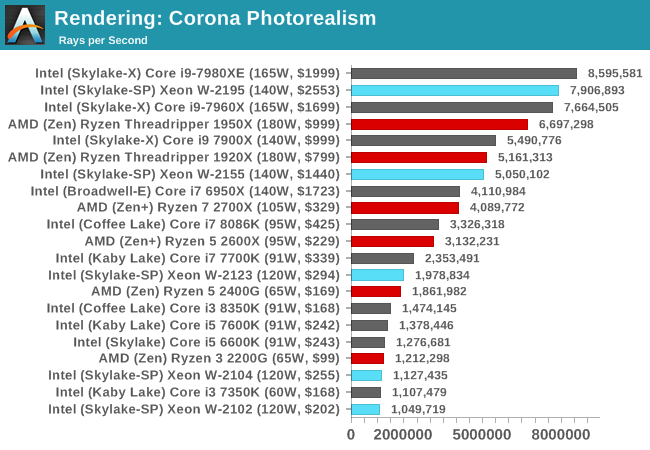
Corona is very multi-threaded, so we expect most of the chips to push their legs on this one. The difference between the W-2195 and the Core i9-7980XE is much more as we expect for a fully MT test, with the W-2155 trading blows with the TR 1920X and the lower quad-core SKUs bringing up the rear.
Blender 2.78: link
For a render that has been around for what seems like ages, Blender is still a highly popular tool. We managed to wrap up a standard workload into the February 5 nightly build of Blender and measure the time it takes to render the first frame of the scene. Being one of the bigger open source tools out there, it means both AMD and Intel work actively to help improve the codebase, for better or for worse on their own/each other's microarchitecture.
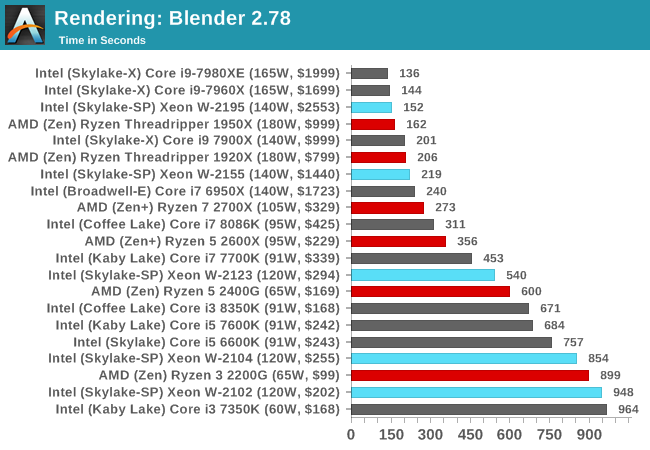
Blender is a very threaded test, but not completely, as we can see with the W-2195 still trailing even the Core i9-7960X. The W-2104 is pushing against the Core i5-6600K, despite the lower frequency, due to the quad-channel memory in play.
LuxMark v3.1: Link
As a synthetic, LuxMark might come across as somewhat arbitrary as a renderer, given that it's mainly used to test GPUs, but it does offer both an OpenCL and a standard C++ mode. In this instance, aside from seeing the comparison in each coding mode for cores and IPC, we also get to see the difference in performance moving from a C++ based code-stack to an OpenCL one with a CPU as the main host.
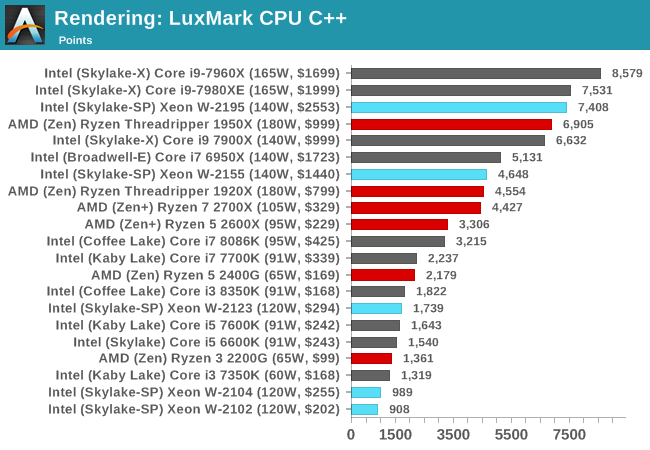
POV-Ray 3.7.1b4
Another regular benchmark in most suites, POV-Ray is another ray-tracer but has been around for many years. It just so happens that during the run up to AMD's Ryzen launch, the code base started to get active again with developers making changes to the code and pushing out updates. Our version and benchmarking started just before that was happening, but given time we will see where the POV-Ray code ends up and adjust in due course.
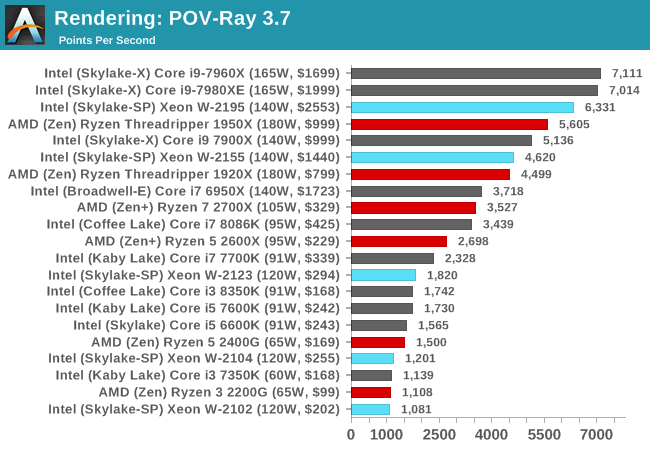
Cinebench R15: link
The latest version of CineBench has also become one of those 'used everywhere' benchmarks, particularly as an indicator of single thread performance. High IPC and high frequency gives performance in ST, whereas having good scaling and many cores is where the MT test wins out.
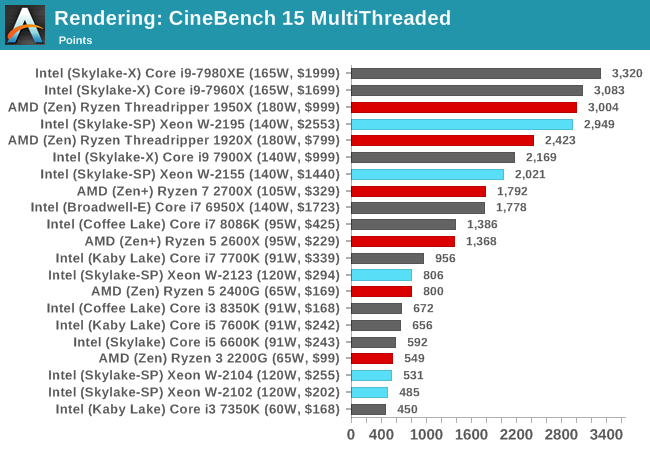

Cinebench is a 'classic' benchmark, despite being four generations behind the Cinema4D software at this point. The W-2195 goes toe-to-toe in the multithreaded test against the TR 1950X, but easily wins against it in the single threaded test. The W-2195 also beats the i9-7980XE in ST, but loses in MT.










74 Comments
View All Comments
HStewart - Monday, July 30, 2018 - link
I am curious why Xeon W for same core count is typically slower than Core X - also I notice the Scalable CPU have much more functionally especially related to reliability. In essence to keep the system running 24/7. Also the Scalable CPU's also appear to have 6 channel memory instead of 4 Channel memory. I wonder when 6 channel memory comes to consumer level CPUs.One test that would be is to see what same core processor for Xeon W vs the Scalar CPU with only one CPU.
Another test that could be interesting is a dual CPU scalable with say 2 12 cores verses 1 24 core of CPU on same level.
Just test to see what it with more cores vs CPU's
duploxxx - Monday, July 30, 2018 - link
one threadripper 2.0 and you can throw all intel configs here into the bintricomp - Monday, July 30, 2018 - link
YeaHHStewart - Monday, July 30, 2018 - link
I wish people keep the topic to the subject and not blab about competitor productsduploxxx - Tuesday, July 31, 2018 - link
if you would know anything about cpu scalable systems you would not ask these questions. a 2*12 vs 1*24 will be roughly 20% slower if your application scales cross the total core count due to in between socket communication. Even Intel provides data sheets on that. No need to test.as long as intel can screw consumers they will not invest anything, you wont get 6 mem lanes in xeon W or consumer unless competition does it and they get nailed. btw why on earth would you need that on a consumer platform?
BurntMyBacon - Tuesday, July 31, 2018 - link
If all things are equal, then what you say is true. There is a known performance drop due to intersocket communications. However, you may have more TDP headroom (depends on the chips you are using) and mostly likely more effective cooling with two sockets allowing for higher frequencies with the same number of active cores. If the workload doesn't require an abundance of socket to socket communications, then it is conceivable that the two socket solution may have merit is such circumstances.SanX - Tuesday, July 31, 2018 - link
Why ARM is just digging its buggers watching the game where it can beat Intel ? Where are ARM server and supercomputer chips? ARM processors soon surpass Intel in transistor count. And for the same amount of transistors ARM is 50-100x cheaper then duopoly Intel/AMD. As an additional advantage for ARM these two segments will soon completely abandon Microsoft.beggerking@yahoo.com - Thursday, August 2, 2018 - link
ARM is RISC which is completely from CISC so applications and os are limited. Microsoft server os has really evolved in every aspect in the last few years that may take RISC years to catch up on the software side.JoJ - Saturday, August 4, 2018 - link
ARM is Fujitsu's choice of successor core to SPARC64+, a architecture Fujitsu invested decades of research and development and testing to offer both commercially and at a national laboratory supercomputing level. ARM is therefore not a knee jerk choice of direction for a very interesting super builder.Obviously you exaggerated a little bit, saying ARM is "50 - 100 times cheaper than AMD/Intel".
I wish I could shake my belief that pedantic literalism in Internet forums in general wasn't preventing broad discussion - we exaggerate in real life without any socially degrading effects, why not online?
OR ate your conversation parties sniffing that obviously -- any person who inadvertently speaks technically inaccurately despite forming perfectly understandable inquiry... as if they are unwashed know nothings, and turning on their heels to end the discussion.....a bit like HN's "we don't tolerate humor here" reactions to innocent attempts at lightening the thread...
but I digress, my point here is your comment above raised a couple of interesting questions, that I feel haven't been answered only because I think readers by themselves first over react to hyperbole, then infil the accepted wisdom to answer your questions, despite you ask about pertinent value critical concerns. I feel that by supplying the answer and dismissing the comment as uninformed, the most important thing happening is the reader voluntarily self reinforcing given marketing positions, and not engaging with the subject at all. I work in advertisingand am actually studying this, because advertising buyers adore this kind of"mind share" but we think that is at odds with the advertising buyers wanting"open minded, engaging, adaptable, innovative" customers.
1. have a look at Serve The Homes review of the Cavium ARM server generations. This architecture is definitely viable and competitive now in a increasing number of application areas.
2. Microsoft Azure has ARM deployed in my estimation at scale second only to Baidu. I am tempted to think it's actually politics that prevents a ARM Azure server machine offering to commercial users, little else. The problem with Microsoft, is user expectation of a all round performance consistency and intel and Microsoft have been working on that smooth delivery for decades.
3. ARM is bit cheaper if you need to do more than a quick recompile with a few architecture options selected.
re when we will see a Azure ARM instance, I think could even be waiting for the ability for Cavium to actually deliver hardware, because unmet demand is a fatal blow to new technology, as well as successful realisation.
All my"quality time" with our server fleet, is spent all hands on the thermal and power profiles of our applications.
We will rewrite to gain fractions of a percentage point where it's a consistent number across runs. Since twenty five years ago, I crashed a colo cage by not considering the power on start surge of a huge half terabyte raid array, power loads obsessed me. Power usage in Cavium ARM looks like a winner for us.
4. BUT I said that,based on data mapping dense thermal sensor arrays, with the functional code paths of the actual application logic in flight across the fleet, at the time. If we're able to calculate the cost benefit of routing a new application function to a specific server, depending on the thermal load and core behaviour at the time of dispatch, I admit we're not very typical for a small scale customer. I think small is a server count below 10,000 here, including any peak on demand usage in case you're consumer retail and sell half price Gucci shoes on Black Monday.
(we got surprised by the reliability of gains from very crude information. Originally we just wanted to see if we could balance the flows in the hot aisle, and even throttle hotspot buildup if we lost some cooling locally. For Intel, we got lots of gains, by sending jobs to not exceed the optimal max turbo clock of a processor, and immediately filling out the slower cores with background chores. AMD and Cavium ARM are not as sophisticated about thermal management, where Intel is keen on overkill recently, eg four nigh identical Xeon Gold SKUs. Just do really read that STH review about this"redundancy of the Xeon processor parts- I came away with a purchase order for the reviewed SKU, because we're so excited about the power management system roles in production deployment, as a competitive advantage.
5. REAL COST ADVANTAGE DEPENDS ON CHANNEL PENETRATION, WITH AMD AT 2%, yes, TWO percent is considered healthy for them today, AMD need to be shipping in far greater volume, to move the money dial to realise the kind of cost advantage SanX is excited about.
Certification of countless applications is hardly begun...
I want to use a ARM workstation, to eat my dog food. This necessitates nvidia Quadro cards support. Yes, I write for a living. I target CUDA for a ever increasing proportion of customer needs. SURE I can just remote machines at will. BUT IF YOU DON'T GIVE CRITICAL DEVELOPERS TRULY GREAT HARDWARE, YOU'RE ABANDONING THE PLATFORM FOR ANY IDEA OF GENERAL DEPLOYMENT.
6. Probably the last sentence should have been standalone here.
I'll just say that we need a workstation as cool as the Silicon Graphics Indy of'93, to get a chance of getting a new GENERAL purpose platform in the mainstream soon.
7. I am constantly a both astounded by the simple fact that we have a chip that good to compete at all, yet scared because I am starting to wonder if we'll ever see sales above"bargaining power level" and platform insurance, and the niche market for companies able to extract whole value chains from controling their entire software ecosystem, something almost nobody in the real world can do.
JoJ - Saturday, August 4, 2018 - link
typo, mea,in point 3, I mean to say, "ARM is NOT cheaper, if you need to do more than a quick recompile.."